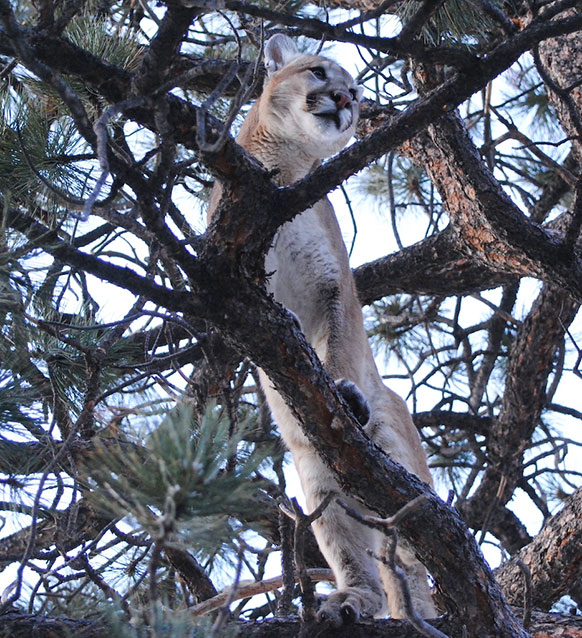UW Researchers Discover Mountain Lions Are Resilient to Human Disturbances at Feeding Sites
Published October 13, 2025

Joseph Holbrook, an associate professor in the Haub School of Environment and Natural Resources, and Justin Clapp, a UW Ph.D. student from Riverton, headed a four-year study in the Casper area that revealed mountain lions showed resilience to human disturbance at feeding sites, staying longer at such sites and often returning multiple times to finish their meals. This treed mountain lion was one of 26 big cats that were tracked by a UW research team during winters from 2019-2023. Their paper will be published in the near future in Proceedings of the Royal Society B. (Cade Bowlin Photo)
Previous studies have shown that mountain lions tend to shy away from feeding sites
that have been disturbed by human presence. However, a group of University of Wyoming
researchers has turned that conventional notion on its head.
Joseph Holbrook, an associate professor in the Haub School of Environment and Natural
Resources, and Justin Clapp, a UW Ph.D. student from Riverton, headed a four-year
study in the Casper area that revealed mountain lions showed resilience to human disturbance
at feeding sites, staying longer at such sites and often returning multiple times
to finish their meals.
“Our research essentially indicates that, contrary to prevailing discussions and insights
within the scientific literature, mountain lions were extremely resilient to human
disturbance at feeding sites -- much more so than the current understanding would
indicate,” says Holbrook, wo also is a faculty member in the Department of Zoology
and Physiology.
The paper, titled “Large carnivore feeding is resilient in human disturbance,” was
accepted and will be published in the near future in Proceedings of the Royal Society B, the Royal Society’s flagship biological research journal that is dedicated to the
publication and dissemination of high-quality research.
Clapp, a large carnivore biologist with the Wyoming Game and Fish Department in Lander,
was the paper’s lead author. Other contributors were Justin Binfet with the Wyoming
Game and Fish Department in Casper, and Cade Bowlin, a wildlife biologist with the
Idaho Department of Fish and Game in Idaho Falls, Idaho.
During the study, the research team captured and monitored 26 mountain lions using
satellite-compatible GPS radio collars during winter seasons that spanned from November
2019-March 2023. The group assigned human disturbances to mountain lion feeding sites,
which included 26 direct encounters; 22 incidents when the mountain lion did not leave
during the human disturbance; 58 disturbances within proximity of the feeding sites;
67 incidents when the mountain lion briefly left a source of food; and 348 incidents
when no feeding disturbances occurred, according to the paper.
Opposite of predictions, human disturbance -- researchers approaching mountain lion
feeding sites on foot -- did not reduce the prey handling times, the paper says. Rather,
the mountain lions spent 87.1 percent longer in mean handling times compared with
feeding events when there was no human disturbance. Mountain lions rarely abandoned
their prey but, instead, waited for disturbances to end and resumed feeding activities,
extending the time dedicated to feeding at the carcass.
Direct encounters between mountain lions and humans made up 24.5 percent of all disturbances,
while proximity encounters comprised 75.4 percent of the remaining disturbances, according
to the paper. Additionally, mountain lions often stayed put in areas where human disturbances
occurred, but fled 17 of 26, or 65.4 percent, of direct encounters. However, the predators
returned to the feeding site 72 percent of the time (74 percent after proximity disturbances
and 64.7 percent after direct encounters). The percentage rises to 80.2 percent overall
when including incidents when mountain lions never left, according to the study.
Additionally, the study found the more times mountain lions experienced human disturbances
at feeding sites, the more likely they were to return to feed -- highlighting the
adaptability of the felines.
“Our results highlight the resilience expressed by mountain lions to human disturbances
in natural feeding environments, where these apex predators’ intelligence, adaptability
and unique life history strategies underlie their proliferation,” Clapp says.
According to the paper, the study can prove valuable to wildlife managers who consider
the effect of disturbances that may alter the fitness of carnivores, such as mountain
lions, as well as alter the abundance of prey in natural wildlife systems.
The research was funded by UW, the Wyoming Game and Fish Department, the Knobloch Family Foundation and the Bureau of Land Management.

